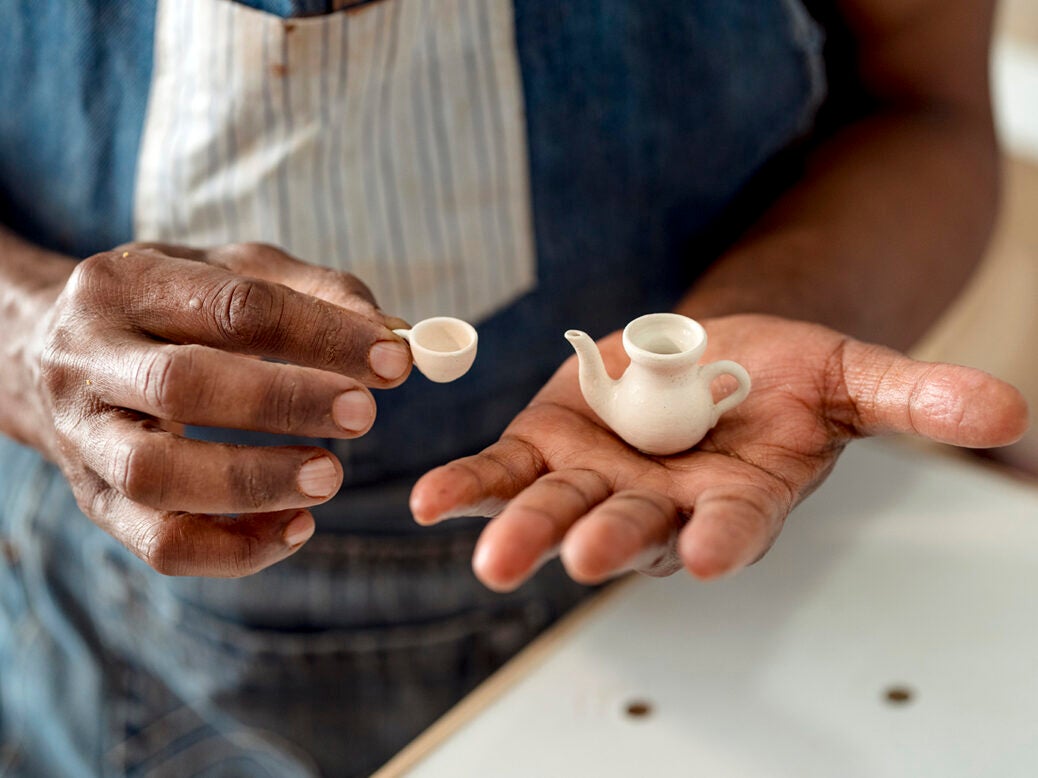
It was 1998, and Kate Santichen had just turned 13 when she discovered that a bottle cap, a small piece of felt, and a handful of beads made the perfect miniature pie. Somewhat reluctantly, her parents and grandmother had just given her a beautiful wooden dollhouse for her birthday – they feared she would grow out of it too quickly, that it would ultimately be a waste. Santichen is now 37 and a producer in New York City, where she continues to make miniature pies – and miniature armchairs, and miniature sun hats, and miniature scratch cards with foil you can really scratch off. “I was right that I wouldn’t grow out of it too quickly,” she says now.
On her Instagram page @the_tiny_craftress, Santichen delights just under 13,000 followers with photos of her creations – her most popular are tiny wicker chairs that she learned how to make during summer classes offered by the International Guild of Miniature Artisans (IGMA). If you’re surprised that there are enough miniaturists in the world to form a guild, then you have underestimated the power of the small – mini crafting is now so popular that Channel 4 launched a reality competition, The Great Big Tiny Design Challenge, in March.
“My family think I’m crackers with this hobby,” says one contestant in the first episode of the show, which sees crafters renovating a dollhouse room by room, week by week. The ten contestants we meet are varied – an animation director from London, a fish and chip shop assistant from Lancashire, a magistrate from Southampton, a garden centre employee from County Carlow in Ireland. What draws people towards life in miniature?
I myself made my first tiny craft in 2018. On a mild September Saturday evening, the day after quitting my full time job to go freelance, I sculpted little blocks of cheese out of yellow clay, hunched over my desk in my London flat with Bridget Jones playing in the background. I then added a dollop of chutney (kitchen towel shredded inside paint) and glued the lot to a mini wooden board. A few days later I made a mini loaf of bread (scraping a brown pastel and brushing the dust on the clay to get that fresh-baked look) – then pebble-sized bowls of ice cream with teeny sprinkles, a fried egg that could fit on a fingernail, and a coin-sized plate of spaghetti with a single clay strand twisted around a dollhouse fork (plus two tiny green basil leaves on top).
Why do I do it? When I first started, it calmed my anxiety and helped me get a handle on the tightness in my chest – but I’m not sure that’s the reason, not really. Miniature crafting can be fiddly and frustrating; I’ve ruined far more projects than I’ve finished, and the whole thing is probably terrible for my eyes and the back of my neck. Do I do it because the end results look cute? (Yes, I guess!) Because it’s one of the few times I actually work with my hands? (Maybe!) Or because it’s rewarding to create something small and insignificant in a world that demands near-constant excess? (Honestly, probably not.)
The truth is I don’t know why I spend hours cutting and squeezing clay until I’ve made a single passable miniature lemon slice – but I do know I’m not alone. “Miniatures seem to spark a childlike wonder in adults. There’s something daydream-like about them,” Santichen says. Mini food, in particular, is especially popular online – Santichen recently used her printer, clay, a toothpick, a plastic bag, tweezers, and some resin to create five boxes of spilled Cheerios over the course of five days. “I think food is so popular because it’s such a universal language. Everyone instantly recognizes a pizza, Cheerios, ramen noodles.”
Interestingly – tellingly? – many popular miniatures are entirely absent of people. The Instagram page @dailymini curates pictures of crafts for 229,000 followers – there’s a mini video store, succulents, KFC, stilettos, and smoked salmon – but while some of these fun-sized items are balanced on fingertips, tiny crafted people very rarely show up on the page. Are we creating and promoting a world for ourselves to inhabit – perhaps to master? “I don’t like dolls with my minis… because I think they distract from the minis themselves,” Santichen says. I’d be lying if I said I hadn’t felt the thrill of being a giant.
Still, miniature making is not lonely or isolated work: the online community around the hobby thrives. “I’ve met mini makers all across the world,” says Santichen, who meets other artists on Zoom for virtual “crafternoons” in which they work on their individual projects while chatting. In 2020, she participated in a global swap between crafters – she received a mini from Canada and sent one to France.
“I think social media has maybe made the miniatures community move away from just being for dollhouses and into more of an artform – people can share, interact and exchange ideas more easily with each other,” says Lynn Allingham, Manchester-based author of Making Mini Food, the book which taught me how to make my little cheeseboard and loaf of bread. “I get tagged in pictures where someone has made something from the book – it’s always such a lovely feeling… it makes all the hard work worth it.”
Oksana Parkhomenko is a 31-year-old engineer from Ukraine who has recently fled to Germany because of the ongoing war. Via email, and using her English-speaking boyfriend’s translation skills, she explains why she delights in crafting mini tomatoes and shockingly realistic kiwis, not to mention cakes and incredibly lifelike lemon slices. “Creating miniature food is like magic to me. I completely immerse myself in the process and forget about time,” Parkhomenko says. She has just under 3,000 followers on her Instagram @cutethingsplace and also sells her miniatures on Etsy.
Parkhomenko first started crafting minis after stumbling upon pictures on Instagram, and she now follows other artists on the site in order to learn new skills. While Parkhomenko says no one locally really understands her craft (“When I tell my friends what I do, they ask to see it, because they have never seen anything like it”), she has been able to connect with like-minded crafters across the globe thanks to the internet.
Unfortunately, Parkhomenko had to leave all of her crafting tools behind while fleeing her home city of Mariupol. Recently, she shared a photo of the ruins of the post office via which she used to send her miniature crafts to customers. For now, “creativity fades into the background”, but, “I do not lose hope that soon this terrible war will end and life will get better,” she says.
To many, a miniature carrot might seem frivolous – a miniature (and amateur) blob of chutney even more so. But to artists scattered across the globe and bonded by a love of sculpting, miniature items help to make the world a smaller place.


